Do you live in Canada? Have you been impacted by pro-landlord policies, especially throughout this pandemic? Are you curious to know if your political representatives at the provincial and federal levels are landlords?
If so, you’re in the right place.
Some elected officials in Canada are required to complete public disclosure reports that contain, in part, property they own (including rental property), and sources of income (including rent). These reports tell us if our elected representatives, and/or their spouses, are landlords.
Most provincial governments, and the federal government, require elected officials to complete these forms. They then make the results public, and often easily accessible. (Manitoba, Newfoundland and Labrador, and the territories either don’t collect this data or make it available online, to the best of my knowledge.)
I’ve gone through all this data and identified which political representatives are landlords by determining if they or their spouse earn rental income and/or own rental property. These reports typically don’t specify the type of rental property, so cottage and vacation home rentals may be included. I did my best to filter out those who own other non-residential property, such as vacant lots, farmland, commercial properties, etc. I also left out political representatives who didn’t make what sort of property they owned clear, so the sections for Nova Scotia, New Brunswick and Prince Edward Island, where this was a common practice, likely undercounts the number of landlords.
This article and its charts are based off the most recently available public data as of March 18, 2021. An MP’s situation may have changed since then. This article will be updated when new information is made available after future elections.
I’ve organized all this data and presented it here by province, in order of population. If you’d like to jump to a certain area, you can do so here: Ontario; Quebec; British Columbia; Alberta; Saskatchewan; Nova Scotia; New Brunswick; Prince Edward Island. The results for the federal level, accurate as of Aug. 23, 2022, are available on another post.
UPDATE: This article was updated on Sept. 20, 2022, to direct readers interested in results on the federal level to an updated article published that day.
Ontario
Ontario makes public disclosures for MPPs easily accessible through an online tool. The data presented is accurate as of September 2020.
Of the 124 MPPs in Ontario, 23 are landlords or have a spouse as a landlord (18.5 per cent). Here is the party breakdown:
- Liberal: 2/8 (25 per cent)
- Conservative: 13/71 (18.3 per cent)
- NDP: 7/40 (17.5 per cent)
- Independent: 1
And here is the full chart with all the details.
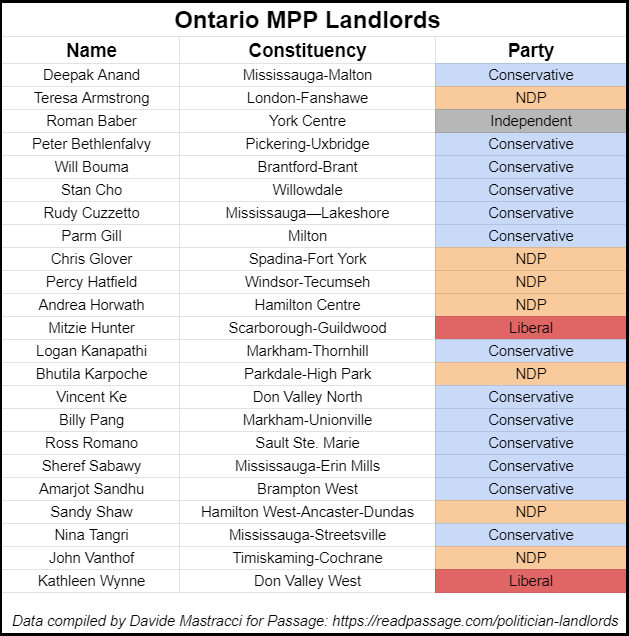
Quebec
Quebec makes public disclosures for MNAs accessible online, with PDF reports available for each one (in French only). The reports were submitted in July 2019 to cover 2017-2018. Unlike other provinces, these reports only included the MNAs, and not their spouses. As a result, the total number on this list is likely less than it would otherwise be.
Of the 125 MNAs in Quebec, 14 are landlords (11.2 per cent). Here is the party breakdown:
- Liberal: 5/28 (17.9 per cent)
- Coalition Avenir Québec: 9/75 (12 per cent)
And here is the full chart with all the details.
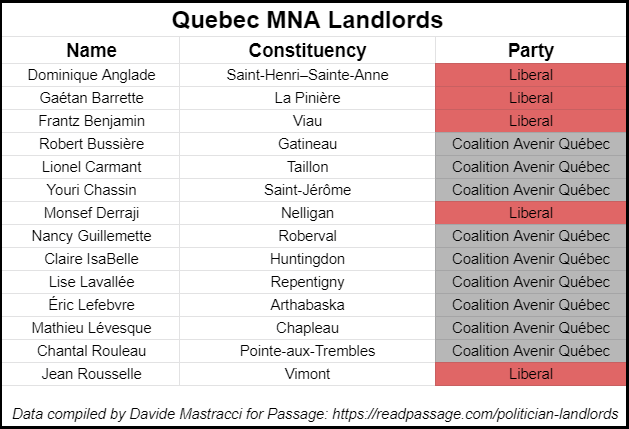
British Columbia
British Columbia makes public disclosures for MLAs accessible online, with PDF reports available for each one. The reports were submitted either in 2019 or 2020, with occasional additional updates made later in 2020, for the 41st Parliament. Unfortunately, the reports for 29 MLAs recently elected aren’t available yet, so this analysis only applies to 58 of the 87 representatives currently in office.
Of the 58 MLAs in British Columbia that have disclosures available, eight are landlords, or have a spouse as a landlord (13.8 per cent). Here is the party breakdown:
- Green: 1/2 (50 per cent)
- NDP: 5/33 (15.2 per cent)
- Liberal: 2/23 (8.7 per cent)
And here is the full chart with all the details.
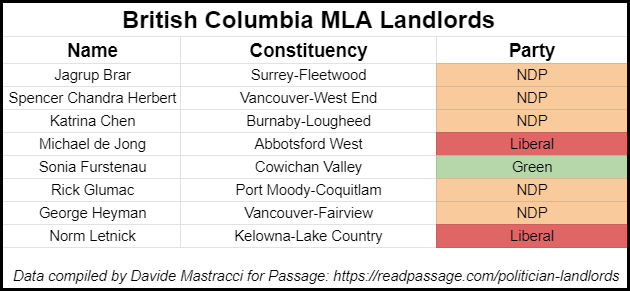
Alberta
Alberta makes public disclosures for MLAs accessible online, with PDF reports available for each one. The reports were submitted either in December 2019, or at varying points throughout 2020.
Of the 87 MLAs in Alberta, 27 are landlords, have a spouse as a landlord and/or own rental property (31 per cent). Four MLAs (Mickey Amery, Rajan Sawhney, David Shepherd and Heather Sweet) and/or their spouses have rental property, but didn’t have rental income listed. They are included in this list. Here is the party breakdown:
- NDP: 9/24 (37.5 per cent)
- United Conservative Party: 18/62 (29 per cent)
And here is the full chart with all the details.
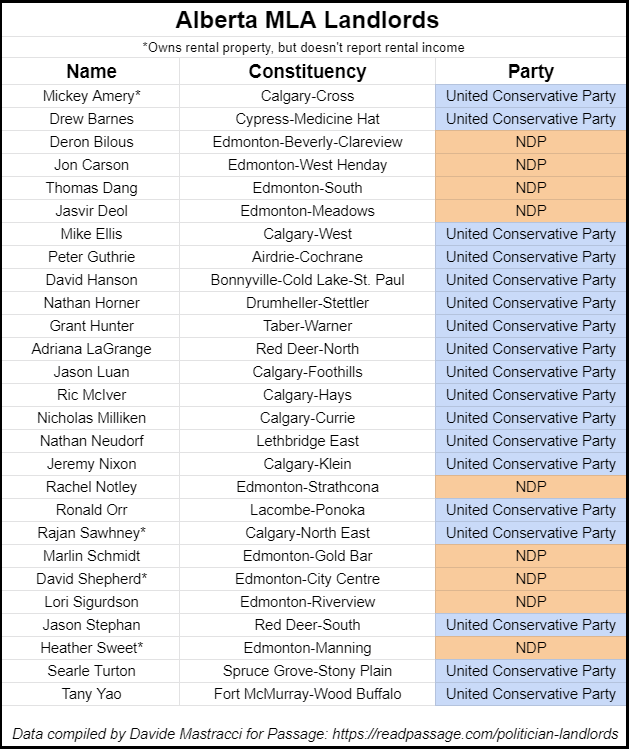
Saskatchewan
Saskatchewan makes public disclosures for MLAs accessible online, with PDF reports available for each one. The reports are as recent as 2020. Unfortunately, the reports for 17 MLAs recently elected aren’t available yet, so this analysis only applies to 44 of the 61 representatives currently in office.
Of the 44 MLAs in Saskatchewan that have disclosures available, eight are landlords, have a spouse as a landlord, and/or own rental property (18.2 per cent). Four MLAs (Don McMorris, Scott Moe, Don Morgan and Greg Ottenbreit) didn’t have rental income listed, but they and/or their spouses were either shareholders in a numbered corporation with rental property, or the president of a company with rental property. They are included in this list. Here is the party breakdown:
- NDP: 2/7 (28.6 per cent)
- Saskatchewan Party: 6/36 (16.7 per cent)
And here is the full chart with all the details:
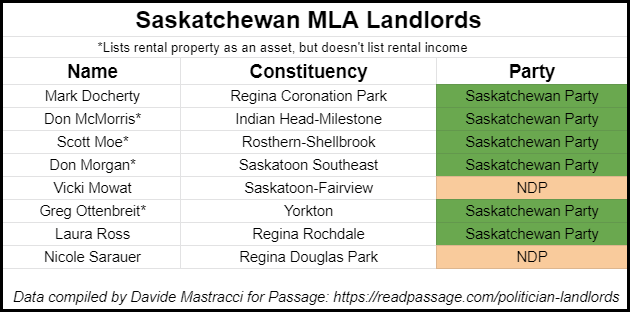
Nova Scotia
Nova Scotia makes public disclosures for MLAs accessible online, contained in a single, non-searchable PDF. The PDF includes reports made throughout 2020. However, these reports only contain new information, and do not reiterate information provided on past claims. This means that, for example, an MLA elected in 2013 who reported rental income would not have to do so again for the same property in subsequent disclosures. As such, the current disclosures likely undercount the number of MLAs who earn rental income and/or own rental property. Because the past disclosures are not available online, the current one becomes less useful. Consequently, the graphic made for Nova Scotia has been removed, as it did not capture this context.
Based on the current disclosure though, in 2020 five of the 51 MLAs in Nova Scotia and/or their spouses reported earning new rental income and/or newly owning rental property. They were: Karen Lynn Casey (Colchester North—Liberal), Randy Delorey (Antigonish—Liberal), Rafah DiCostanzo (Clayton Park West—Liberal), John Lohr (Kings North—Conservative) and Iain Rankin (Timberlea-Prospect—Liberal).
New Brunswick
New Brunswick makes public disclosures for MLAs accessible online, with PDF reports available for each one. The reports are as recent as December 2019. Unfortunately, the reports for 12 MLAs recently elected aren’t available yet, so this analysis only applies to 37 of the 49 representatives currently in office.
Of the 37 MLAs in New Brunswick that have disclosures available, one lists residential property as an asset, despite reporting no income. That MLA is Benoît Bourque (Kent South—Liberal.) Five other MLAs (Jean-Claude D’Amours, Bruce Fitch, Lisa Harris, Gilles LePage and Mary E. Wilson) and/or their spouses listed real property, but didn’t indicate the nature of it. They weren’t included in the list.
Due to the lack of data, a graphic hasn’t been prepared for New Brunswick.
Prince Edward Island
Prince Edward Island makes public disclosures for MLAs accessible online, with PDF reports available for each one. The reports are accurate as of 2020.
Of the 27 MLAs in PEI, two and/or their spouses own rental property. They are Matthew MacKay (Kensington-Malpeque—Conservative) and Gordon McNeilly (Charlottetown-West Royalty—Liberal.) Three other MLAs (Cory Deagle, Ernie Hudson and Brad Trivers) and/or their spouses listed real property, but didn’t indicate the nature of it. They weren’t included in the list.
Due to the lack of data, a graphic hasn’t been prepared for Prince Edward Island.
UPDATE: The Nova Scotia section of this article was updated shortly after publication to clarify the nature of the disclosures provided and adjust the presented data accordingly.







